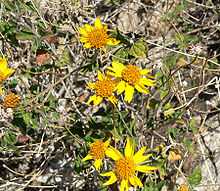Bahiopsis parishii
| Bahiopsis parishii | |
|---|---|
 | |
| Scientific classification | |
| Kingdom: | Plantae |
| (unranked): | Angiosperms |
| (unranked): | Eudicots |
| (unranked): | Asterids |
| Order: | Asterales |
| Family: | Asteraceae |
| Genus: | Bahiopsis |
| Species: | B. parishii |
| Binomial name | |
| Bahiopsis parishii (Greene) E.E.Schill. & Panero[1] | |
| Synonyms | |
|
Viguiera deltoidea var. parishii (Greene) Vasey & Rose | |
Bahiopsis parishii known commonly as Parish goldeneye or shrubby goldeneye, is a flowering shrub in the family Asteraceae.
It is native to the southwestern United States, including southern California, far southern Nevada, and much of Arizona, as well as adjacent parts of northwest Mexico (Baja California and Sonora).
Description
Bahiopsis parishii grows to 2 feet tall, with bright yellow flowers. It is a plant of desert areas, usually associated with creosote bush, and ranges from sea level to 5,000 ft (1,500 m) in elevation. It blooms after periods of rain, both in spring and in fall, or after the monsoon season in Arizona.
Taxonomy
The species name honors either of two brothers, Samuel Bonsall Parish (1838–1928) and William Fletcher Parish (1840–1918), both active botanists in southern California. It is closely related to Bahiopsis deltoidea and is sometimes considered a variety of that species.
References
- ↑ "Bahiopsis parishii". Integrated Taxonomic Information System. Retrieved 2013-12-16.
- ↑ "Taxon: Bahiopsis parishii (Greene) E. E. Schill. & Panero". Germplasm Resources Information Network. United States Department of Agriculture. 2007-05-11. Retrieved 2013-12-16.
External links
![]() Data related to Bahiopsis parishii at Wikispecies
Data related to Bahiopsis parishii at Wikispecies
- Viguiera parishii profile at Calflora
- Viguiera parishii range map at Calflora
- Bahiopsis parishii at eFloras
- Jepson Manual Treatment
- Photo gallery
| Wikimedia Commons has media related to Bahiopsis parishii. |